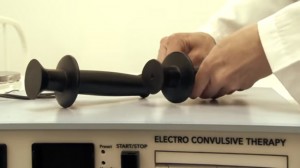By Kelly Patricia O’Meara
Published by CCHR International
The Mental Health Industry Watchdog
July 22, 2016
The Citizens Commission on Human Rights (CCHR) requests that Congress investigate what appear to be serious conflicts of interest driving the Food and Drug Administration’s (FDA’s) decision to allow the wider use electroshock “treatment” (ECT).
On July 18, 2016, The Washington Post reported that the FDA determined that for some patients, the use of electroshock—up to 460 volts of damaging electricity through the brain, is helpful and, therefore, justifying a lower risk classification for the shock device.[1] CCHR charges that this could put vulnerable children and elderly at risk.
Right now, the ECT device carries the highest-risk, Class III classification, and rightfully so, as the device makers have never submitted any clinical evidence to the FDA to prove that the procedure is safe or effective.[2] To remain as Class III, the manufacturers must provide an application to the FDA with clinical trials to prove the device won’t cause harm.
More than 3,000 individuals have written to the FDA in opposition of lowering the risk classification of the shock device because of its dangers, which the FDA is, apparently, choosing to ignore. In late June, Jason Chaffetz, Chairman of House Committee on Oversight and Reform took the FDA to task, writing to Sylvia Matthews Burwell, the Secretary of Health and Human Services, which oversees the FDA, raising concerns about the adverse effects of ECT. These effects include cardiovascular (heart and blood vessels) complications, cognition and memory impairment, death, physical trauma, dental trauma, prolonged seizures and worsening of psychiatric symptoms.[3]
Chairman Chaffetz posed a number of important questions to the Secretary writing, “Given the complexity of this issue, and your admission that the long-term effectiveness of these devices remains debated,” what are the known dangers for those 18 years and younger receiving ECT, how does the FDA propose to monitor the use of ECT, and what Federal tax dollars have been appropriated to pay for ECT. The lawmaker further requested information about how “information on patient population or use is tracked if at all, and provide the underlying data.”[4]

The FDA claims that every year 100,000 Americans are administered ECT, but this statistic dates back to the 1990s and the FDA has provided no records to substantiate such limited use.
The amount of information that has not been made public is astounding. For example, the FDA claims that every year 100,000 Americans are administered ECT, but this statistic dates back to the 1990s and the FDA has provided no records to substantiate such limited use, nor has it provided information as to how many children and the elderly are subjected to ECT.[5]
While The Washington Post’s article conceded what psychiatrists still admit after 70 years of ECT use: the so-called beneficial results of electroshock are “for reasons not fully understood,” the fact is there is no scientific evidence to support ECT works at all.
Hot on the heels of the Post’s article was a study funded by the National Institute of Mental Health (NIMH) that predictably found ECT to be a key component in maintaining remission in depression in the elderly, according to psychiatrist Sarah Lisanby, one of the lead researchers. The study, called Prolonging Remission in Depressed Elderly (PRIDE), examined 240 patients, over the age of 60, who received electroshock and the antidepressant venlafaxine, the generic of Effexor. Those that apparently “bettered” went on to receive either venlafaxine combined with the mood stabilizer, lithium, or underwent more ECT and venlafaxine.[6]
But what neither the above study, nor NIMH, mentions is the potential death rate in the elderly receiving ECT, or the damage the violence of such shock “treatment” can cause. Consider that in March of this year, a coroner from Sunderland County in the United Kingdom determined that 71-year-old Elsie Tindle died after electroshock triggered an epileptic fit, which caused irreparable brain damage. A government pathologist concluded Tindle suffered a permanent epileptic seizure and the brain was completely starved of oxygen during the prolonged fit in 2015. After the third ECT session, Ms. Tindle fell ill the following day and died 25 days later.[7]
Additionally, in the United States, 60-year-old Peggy Salters was administered electroshock following the death of several close family members, including her husband. The psychiatrist who administered the ECT observed Salters was “confused and disoriented” and stopped the treatment because she was “completely unable to function.” Salters held a Master of Science in Nursing, had a long career as a psychiatric nurse, but lost knowledge of nursing skills and was unable to return to work after the ECT. Salters lost all memories of her husband and the births of her three children.[8] In 2005, a jury in Columbia, South Carolina, awarded Salters $635,177, finding that the loss of 30 years of memory and cognitive impairment was due to ECT.[9]

One must consider what appear to be serious conflicts of interest associated with the FDA’s pending decision.
Of great importance, given the following information, one must consider what appear to be serious conflicts of interest associated with the FDA’s pending decision. The NIMH and the PRIDE study, released perhaps to buoy the FDA’s unpopular stance on ECT, fails to fully disclose the conflicts of interests of the researchers, including financial links and/or affiliations with the two U.S. electroshock device makers, MECTA and SOMATICS. They include:
- Charles Kellner, the Director of the ECT service at the Mount Sinai Hospital in New York City was a consultant for MECTA and SOMATICS.[10] From 1994 to 2004, he was the Editor-in-Chief of the Journal of ECT, which was founded by Dr. Max Fink, who made videos about ECT for SOMATICS.[11]
- Richard D. Weiner has a long-standing relationship with MECTA and consulted for SOMATICS.[12] He was an engineer who developed ECT machines for MECTA and wrote their instruction manuals.[13] He was once on the Speaker’s Bureau of MECTA.[14] He is a co-inventor on a Duke University patent licensed to MECTA.[15]
- Matthew Rudorfer is a psychiatrist and Chief of NIMH’s Somatic Treatments Program who administers and oversees grant money, including to colleagues that advocate ECT. Rudorfer co-wrote an ECT textbook with Dr. Harold Sackeim, Ph.D., who has received at least $8 million over 20 years from NIMH while having been a consultant to MECTA and SOMATICS.[16] Rudorfer is the co-author of a 2011 study on ECT with Kellner (above) claiming ECT’s “unsurpassed efficacy and remarkable safety.”[17] In 2011, Rudorfer told The New York Times it would be “too expensive” for “mom and pop” operations such as the manufacturers of ECT devices to conduct clinical trials to prove safety.[18]
- Sarah Lisanby, now part of the NIMH, is on the Editorial Board of the Journal of ECT, along with Harold Sackeim and Max Fink (who have financial conflicts with ECT device makers) and Dr. Richard Abrams, co-owner of SOMATICS, Inc.[19] She, too, excuses the manufacturers, saying it is unlikely they could “finance the studies required to get it approved….”[20]
Clearly there appear to be relationships in this process that need to be reviewed and, while the FDA spokeswoman, Deborah Kotz, explained to the Post that “the agency plans to review all the comments submitted” before a final determination is made, the recent media, along with the PRIDE study lauding praise on ECT, has groups seeing this as a vested push to lower the risk classification. For these reasons and the risks to the public health, CCHR reiterates an earlier call for Congress to investigate the apparent conflicts of interest associated with ECT devices at the FDA and NIMH, and ensure the FDA maintains a Class III risk certification for the electroshock device.
Kelly Patricia O’Meara is an award-winning former investigative reporter for the Washington Times’ Insight Magazine, penning dozens of articles exposing the fraud of psychiatric diagnosis and the dangers of the psychiatric drugs—including her ground-breaking 1999 cover story, “Guns & Doses,” exposing the link between psychiatric drugs and acts of senseless violence. She is also the author of the highly acclaimed book, Psyched Out: How Psychiatry Sells Mental Illness and Pushes Pills that Kill. Prior to working as an investigative journalist, O’Meara spent sixteen years on Capitol Hill as a congressional staffer to four Members of Congress. She holds a B.S. in Political Science from the University of Maryland.
References:
[1] “FDA: Electroshock has risks but is useful to combat severe depression,” The Washington Post, 18 July 2016, https://www.washingtonpost.com/national/health-science/fda-electroshock-has-risks-but-is-useful-to-combat-severe-depression/2016/07/18/4a109cbc-2f4e-11e6-9de3-6e6e7a14000c_story.html?postshare=7721468884912250&tid=ss_tw
[2] “FDA: Electroshock has risks but is useful to combat severe depression,” The Washington Post, 18 July 2016, https://www.washingtonpost.com/national/health-science/fda-electroshock-has-risks-but-is-useful-to-combat-severe-depression/2016/07/18/4a109cbc-2f4e-11e6-9de3-6e6e7a14000c_story.html?postshare=7721468884912250&tid=ss_tw.
[3] https://oversight.house.gov/wp-content/uploads/2016/07/2016-06-28-JEC-to-Burwell-HHS-ECT-FDA-due-7-12.pdf.
[4] https://oversight.house.gov/wp-content/uploads/2016/07/2016-06-28-JEC-to-Burwell-HHS-ECT-FDA-due-7-12.pdf.
[5] “ “FDA Executive Summary Prepared for the January 27-28, 2011 meeting of the Neurological Devices Panel,” FDA, http://www.fda.gov/downloads/AdvisoryCommittees/CommitteesMeetingMaterials/
MedicalDevices/MedicalDevicesAdvisoryCommittee/NeurologicalDevicesPanel/
UCM240933.pdf.
[6] “Electroconvulsive Therapy Lifts Depression, Sustains Remission in Older Adults,” National Institute of Mental Health, 18 July 2016, http://www.nimh.nih.gov/news/science-news/2016/electroconvulsive-therapy-lifts-depression-sustains-remission-in-older-adults.shtml.
[7] Petra Silfverskiold, “Electric shock therapy led to Sunderland patient having permanent fit,” Daily Mail (UK), 10 Mar. 2016, http://www.sunderlandecho.com/news/local/all-news/electric-shock-therapy-led-to-sunderland-patient-having-permanent-fit-1-7786233.
[8] http://endofshock.com/litigation.htm.
[9] Case 03CP4004797, Richland County, South Carolina, Filed October 03, 2003, Decided June 17, 2005, http://suemypsychiatrist.wordpress.com/category/ect/.
[10] Linda Andre, Doctors of Deception: What They Don’t Want You to Know about Shock Treatment, (Rutgers University Press, 2009) p. 101.
[11] “ECT Experts’ Ties to Shock Machine Industry,” http://www.ect.org/news/posta.html.
[12] Linda Andre, Doctors of Deception: What They Don’t Want You to Know about Shock Treatment, (Rutgers University Press, 2009) p. 198-199.
[13] Electroconvulsive Therapy, ECT Task Force report, (APA) Sept. 1978, pp. iii; Linda Andre, Doctors of Deception: What They Don’t Want You to Know about Shock Treatment, (Rutgers University Press, 2009) p. 198-199.
[14] Program, American Psychiatric Association 2005 Annual Meeting, Atlanta, GA, May 2005; http://journals.lww.com/ectjournal/Citation/1990/06000/The_1978_and_1990_
APA_Task_Force_Reports_.2.aspx.
[15] Mehul Mankad, MD, et al., “Clinical Manual of Electroconvulsive Therapy,” American Psychiatric Publishing, Inc., 2010, http://psychoreanimatology.org/download/books/Clinical_Manual_of_
Electroconvulsive_Therapy_2010.pdf.
[16] Linda Andre, Doctors of Deception: What They Don’t Want You to Know about Shock Treatment, (Rutgers University Press, 2009) pp.192-196; https://books.google.com/books?id=SFw5SLgAm9sC&pg=PA239&lpg=PA239&dq=Matthew+Rudorfer++
Harold+Sackeim+ECT&source=bl&ots=VHMLYw1vOZ&sig=vkao14xRnI
ZfCUilbva9OtaldCA&hl=en&sa=X&ved=0ahUKEwjJ-fuL8M_KAhVJ2GMKHZtEAxEQ6AEIJTAC#v=onepage&q=
Matthew%20Rudorfer%20%20Harold%20Sackeim%20ECT&f=false
[17] http://www.karger.com/article/pdf/328943.
[18] “F.D.A. Is Studying the Risk of Electroshock Devices,” The New York Times, 23 Jan. 2011, http://www.nytimes.com/2011/01/24/business/24shock.html; Susan FitzGerald, “Despite Protests, Shock Treatment Gains New Respect,” Philly.com (Philadelphia Inquirer), 17. Oct. 1998, http://articles.philly.com/1988-10-17/news/26272212_1_ect-mental-patient-harold-sackeim.
[19] Journal of ECT Editorial Board, http://journals.lww.com/ectjournal/pages/editorialboard.aspx.
[20] Jim Amos, “Future of ECT as Life-Saving Treatment at Risk?” The Practical Psychosomaticist, March 10, 2011, http://jajsamos.wordpress.com/2011/03/10/future-of-ect-as-life-saving-treatment-at-risk/; “Study: Electromagnets Can Relieve Depression,” CBS News, 5 May, 2010, http://www.cbsnews.com/2100-500368_162-6462525.html.



